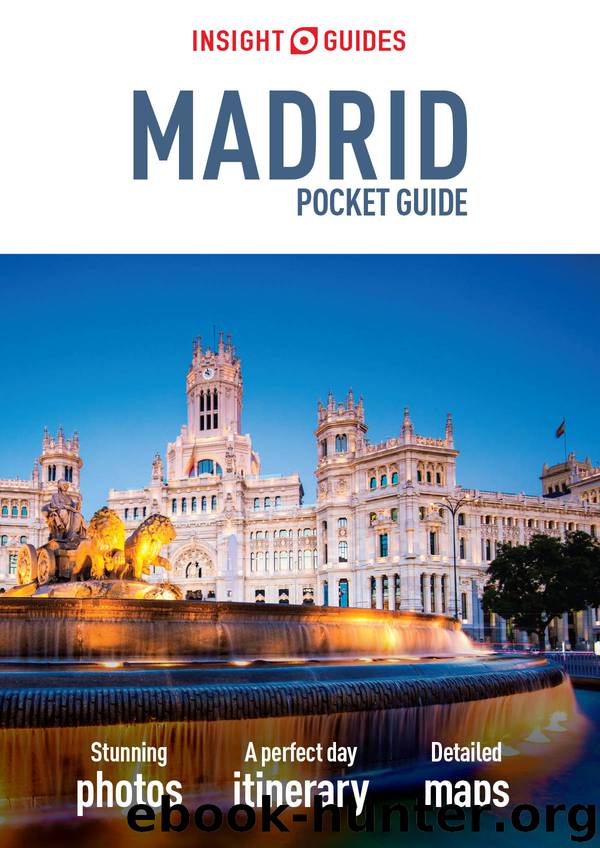Insight Guides: Pocket Madrid by Insight Guides

Author:Insight Guides
Language: eng
Format: epub
Tags: Travel, Spain
Publisher: APA
Published: 2016-03-20T16:00:00+00:00
Toledo’s impressive Alcázar
Dreamstime
Toledo
If you have just one day available for an excursion from Madrid, Toledo • [map], the country’s Visigothic capital in the 6th century, is a good choice. Originally a Roman fortress, it reached its zenith in the Muslim period and after the Christian Reconquest by Alfonso VI in the 11th century, when it became capital of Castile. Alfonso was crowned emperor of Spain and a two-century ‘Golden Age’ ensued. The court’s transfer to Madrid in 1561 triggered the economic decline of the former capital. Nearly four centuries of stagnation ensured Toledo’s preservation as one of the world’s great medieval cities.
To enjoy Toledo’s history and beauty at its best you need to work around the massive influx of tourists it receives on day excursions. Even Toledo’s renowned steel craftsmen, whose traditional skills such as ‘damascening’ – cutting pigmented patterns in the metal – are rooted in the city’s Moorish heritage, have had to take action against the producers of thousands of trashy items sold as souvenirs. So while the city may be seen in a day (a high-speed train from Atocha makes the journey in 35 minutes), the best way to avoid the crowds and enjoy the historic centre is to stay overnight (www.toledo-turismo.com).
A good place to start a visit is Museo de Los Concilios y Cultura Visigoda A [map] (Iglesia de San Roman; Tue–Sat 10am–2pm and 4–6.30pm, Sun 10am–10pm), which explores the city’s Visigothic legacy. It is housed in the beautiful 13th-century mudéjar church of San Roman, which was probably built on the ruins of an earlier mosque, which in turn was built on the site of a Visigoth church. Such are the layers of Toledo’s history.
Before the structure of the Church crystallised and Toledo’s cathedral became the symbol of its power, there was a period of relative tolerance in the late Middle Ages when Islam, Christianity and Judaism coexisted quite comfortably. Their famed convivencia, as it is known, produced a cultural flowering expressed in medicine and the sciences, literature and translation, architecture and the arts. In particular, the mudéjar architecture and decoration created by Muslim craftsmen who stayed in Spain after the Reconquest reached a high point here between the 12th and 16th centuries. It was adopted by the Jewish community, too, after the onset of Christian persecution in the 14th century.
Two historic synagogues stand on the southwestern slope of the city – the Sinagoga del Tránsito B [map] (changing visitor hours), built for Pedro the Cruel’s treasurer, Samuel Levi, in the second half of the 14th century and today containing the small Museo Sefardi; and the 13th-century Sinagoga de Santa María la Blanca C [map] (daily 10am–5.45pm, summer until 7pm). Both show strong Moorish influence in their design, with horseshoe arches, arabesques and glazed tiles. By contrast, all that remains of the Muslim past is the Mezquita Cristo de la Luz D [map], later converted into a church, above the Puerta del Sol; and the Puerta de la Bisagra, the main entry point for visitors coming from Madrid.
Download
This site does not store any files on its server. We only index and link to content provided by other sites. Please contact the content providers to delete copyright contents if any and email us, we'll remove relevant links or contents immediately.
Spell It Out by David Crystal(36021)
Underground: A Human History of the Worlds Beneath Our Feet by Will Hunt(11997)
A Year in the Merde by Stephen Clarke(5297)
Venice by Jan Morris(2513)
Claridge's: The Cookbook by Nail Martyn & Erickson Meredith(2345)
My Paris Kitchen: Recipes and Stories by Lebovitz David(2230)
A TIME OF GIFTS by Patrick Leigh Fermor(2142)
The Plantagenets by Dan Jones(2023)
Welcome to the Goddamn Ice Cube by Blair Braverman(1981)
The Finnish Way by Katja Pantzar(1921)
From Russia with Lunch by David Smiedt(1919)
Top 10 Prague (EYEWITNESS TOP 10 TRAVEL GUIDES) by DK(1912)
Bang Poland: How To Make Love With Polish Girls In Poland by Roosh V(1909)
The Isle of Mull by Terry Marsh(1879)
A TIME TO KEEP SILENCE by Patrick Leigh Fermor(1850)
Rick Steves London 2018 by Rick Steves & Gene Openshaw(1811)
A Taste of Paris by David Downie(1800)
Insight Guides Experience Tokyo by Insight Guides(1756)
Merde in Europe by Stephen Clarke(1712)
